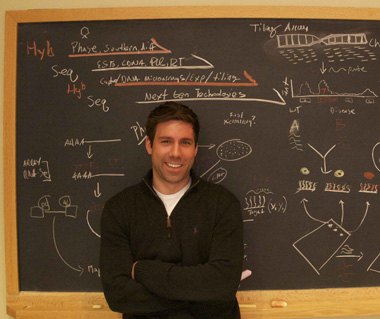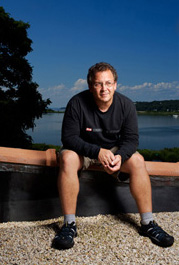Six New Researchers of Renown Join UAlbany's RNA Institute Scientific Advisory Board
 |
|
John L. Rinn, assistant professor of stem cell and regenerative biology at Harvard University, and one of six new members of The RNA Institute's Scientific Advisory Board.
|
ALBANY, N.Y. (October 22, 2012) – Six of the world’s leading RNA researchers have joined the Scientific Advisory Board for The RNA Institute of the University at Albany. The elite group of scientists and investigators provide strategic guidance to the more than 50 affiliated researchers at the Institute.
“We are extremely honored and fortunate to have brought onto The RNA Institute’s Scientific Advisory Board six renowned professionals who have made distinguished contributions to RNA science and its deployment in the diagnosis and treatment of diseases,” said Paul Agris, director of The RNA Institute. “Their guidance will be of immeasurable aid as the Institute continues to evolve into New York’s national research resource for RNA science.”
The new members include:
- Gregory J. Hannon, investigator with the Howard Hughes Medical Institute, a member of the National Academy of Science, and professor at Cold Spring Harbor Laboratory. Hannon is at the forefront of the field of RNA interference (RNAi), a powerful new tool for gene analysis and discovery which allows researchers to selectively turn off genes in living cells.
- Alan M. Lambowitz, director of the Institute for Cellular and Molecular Biology and Mr. & Mrs. A. Frank Smith, Jr. and Nancy Lee & Perry R. Bass Regents Chairs In Molecular Biology at the University of Texas at Austin, and a member of the National Academy of Science. Lambowitz’s laboratory team studies gene expression, RNA splicing, catalytic RNAs, and retroviral-like genetic elements, including possible ancestors of HIV-1 and leukemia viruses.
 |
|
National Academy of Science member Gregory J. Hannon.
|
- David Lilley, professor of molecular biology and director of the Cancer Research UK Nucleic Acid Structure Research Group at the University of Dundee, and a fellow of the Royal Society. Lilley’s work centers on the structure of DNA junctions which are important in recombination and repair, and their interactions with proteins.
- John L. Rinn, assistant professor of stem cell and regenerative biology at Harvard University and Medical School and a senior associate member of the Broad Institute. His team’s research aims to understand the role of long intergenic non-coding RNAs (lincRNAs) in establishing the distinct epigenetic states of adult and embryonic cells and their misregulation in diseases such as cancer.
- Tom Tuschl, investigator with the Howard Hughes Medical Institute and professor and head of the Laboratory of RNA Molecular Biology at The Rockefeller University. Tuschl, a German biochemist and molecular biologist, has gained international recognition in genetics for his studies of RNA interference, which enables “switching off” certain genes by introducing synthetic short RNA into the cell.
- Gabriele Varani, professor of biochemistry and professor of chemistry at the University of Washington and a member of the European Academy of Sciences. Varani uses NMR spectroscopy to elucidate the structure and the dynamics of protein-RNA complexes. He explores the rational, structure-based design of protein and small molecules that target RNA and interfere with gene expression and the replication of pathogenic viruses such as HIV and Hepatitis C.
These new board members join existing scientific advisory board members:
- Ronald Breaker, investigator, Howard Hughes Medical Institute; Henry Ford II Professor, Department of Molecular, Cellular and Developmental Biology and professor of molecular biophysics and biochemistry at Yale University;
- Thomas R. Gingeras, professor and head of functional genomics at the Cold Spring Harbor Laboratory;
- Larry Gold, member, National Academy of Sciences; professor of molecular, cellular and developmental biology at University of Colorado at Boulder; and CEO of Somalogic, Inc.;
- Rachel Green, investigator, Howard Hughes Medical Institute; associate professor, Department of Molecular Biology and Genetics at The Johns Hopkins University School of Medicine;
- Christine Guthrie, member, National Academy of Sciences; professor, Department of Biochemistry and Biophysics at University of California - San Francisco;
- Dieter Söll, member, National Academy of Sciences; Sterling Professor of Molecular Biophysics and Biochemistry and professor of Chemistry at Yale University;
- Eric Westhof, member, European Academy of Sciences; university professor and head of the UPR 9002-ARN CNRS Institut de biologie moléculaire et cellulaire du CNRS; and
- Ada E. Yonath, 2009 Nobel Laureate; member, National Academy of Sciences; director, The Helen and Milton A. Kimmelman Center for Biomolecular Structure and Assembly, and professor, Department of Structural Biology, at the Weizmann Institute.
Launched in June 2010, The RNA Institute brings together more than 50 investigators from UAlbany's College of Arts and Sciences, College of Nanoscale Science and Engineering, and School of Public Health, and regional institutions including the New York State Department of Health Wadsworth Center, Rensselaer Polytechnic Institute, and Albany Medical College.
The RNA Institute offers advanced facilities, including a Mass Spectrometry Center and high-end computational equipment, to support the many research projects underway. The Institute has attracted more than $14 million in research support from the state and federal governments, and private corporations.
The Institute recently launched the construction of its new state-of-the-art facility for biomedical technology development and commercialization. The national research resource was awarded $2 million through Governor Andrew M. Cuomo’s Regional Council initiative and designated a priority project by the CREDC for its ability to retain and create jobs across New York state.
Learn more about The RNA Institute scientific team and the implications of its cutting-edge research for development and delivery of innovative medicines, vaccines and diagnostics.
![]() For more news, subscribe to UAlbany's RSS headline feeds
For more news, subscribe to UAlbany's RSS headline feeds
A comprehensive public research university, the University at Albany-SUNY offers more than 120 undergraduate majors and minors and 125 master's, doctoral and graduate certificate programs. UAlbany is a leader among all New York State colleges and universities in such diverse fields as atmospheric and environmental sciences, business, education, public health,health sciences, criminal justice, emergency preparedness, engineering and applied sciences, informatics, public administration, social welfare and sociology, taught by an extensive roster of faculty experts. It also offers expanded academic and research opportunities for students through an affiliation with Albany Law School. With a curriculum enhanced by 600 study-abroad opportunities, UAlbany launches great careers.


